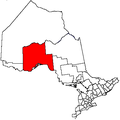Ojibway Nation of Saugeen | |
|---|---|
| Ojibway Nation of Saugeen (Savant Lake) Indian Reserve | |
| Coordinates: 50°27′N90°42′W / 50.450°N 90.700°W | |
| Country | |
| Province | |
| District | Thunder Bay |
| First Nation | Ojibways of Saugeen |
| Area | |
| • Land | 57.06 km2 (22.03 sq mi) |
| Population (2021) [1] | |
• Total | 88 |
| • Density | 1.5/km2 (4/sq mi) |
The Ojibway Nation of Saugeen is an Ojibwa First Nation in the Canadian province of Ontario. The Nation is located in the Thunder Bay District, approximately 20 kilometres northwest of Savant Lake. In December, 2007, its total registered population was 206, of which the on-reserve population was 72. The community maintains strong ties with Mishkeegogamang First Nation
Contents
The Ojibway Nation of Saugeen's landbase consists of a 5,986 ha Ojibway Nation of Saugeen Indian Reserve.

